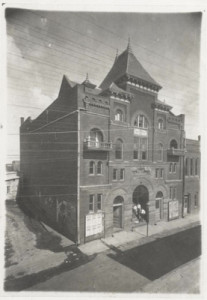
The opulent King Opera House was one of several opera houses and motion picture theaters in Greenville from 1911-1919. The King was destroyed by fire at least two times. This photograph shows the building in 1901. (From Images of America: Greenville by Carol Taylor)
Shortly after the arrival of the railroads in 1880, two Greenville merchants turned the upper floors of their stores into Opera Houses. On the west side of the square was the Rainey. Alexander “Sandy” Cameron ran the Cameron Opera House above his store where Landon’s Winery is now located. Local gossip has it that Cameron spread rumors about the physical stability of the Rainey building. Something about weak joists and rickety floors. Soon, the Rainey closed leaving the Cameron as the place to be seen.
By the early 1890s, Tom King and a group of investors built a new theater on Wesley Street between Lee and Jordan Streets. The building faced west. Shortly after the opening of the venture, Tom King bought out his partners and set out to make the King Opera House one of the best in the state of Texas, if not the country.
We are all familiar with the King family scandals, but I was surprised to learn that the King was not the only opera house in Greenville through 1919. In 1911 there were four theaters here, the King managed by Walter Bean at 2409 Wesley, and three managed by E. J. Lamkin. Lamkin’s theaters included the Colonial at 2707 Lee Street showing motion pictures, the seasonal open-air Airdome on a vacant lot at 2909 Lee Street, and the Lyric at 2609 Stonewall that played vaudeville. That was the only year listed for the Airdome, but by 1913 the Colonial had moved to 2608 Lee Street and the Lyric was still playing vaudeville but moved to 2707 Lee Street. The King Opera House had no change. However, the Empress was the newest theater at 2814 Lee Street to show moving pictures.
By 1916 the Colonial doubled its seating capacity at the same location, the King was located at 2404 Wesley Street with seating for 895 persons, and the Lyric changed its name to the Savoy but stayed at the same place. The Empress became the Queen located at 2814 Lee Street and the new Pastime Theater was located at 3022 Johnson. At the end of World War I, Greenville was home to the same theaters but subtle changes had occurred. The King Opera House was now a motion picture theater as well as an opera house. The Pastime and the Queen remained motion pictures theaters while the Savoy; like the King showed moving pictures as well as live vaudeville acts.
What caused the transformation from vaudeville to motion or moving pictures? During World War I rail transportation was needed to move troops and war materiel. Construction, entertainment, and other non-essential goods found it impossible to simply get a seat or spot on the train. A reel of film was much easier to move than a troupe of actors, their sets, and costumes. Besides, motion pictures were the latest rage after almost two years of wartime restrictions.
For most of their history motion pictures were forms of inexpensive entertainment. With so many theaters up and down Lee Street, managers often turned to creative methods to attract audiences. One such ruse was to hire young men who played loud musical instruments, horns, drum, and the like, to stand in front of the theater when it opened to literally drum up business. The young men clerked in nearby stores, took a short lunch break, and returned to the store when an audience was in the theater.
A drawback to the popularity of early motion picture theaters was the composition of the film. It was primarily made of celluloid, a cotton by-product with a low flashpoint. Projectors often caught fire, and the audience was evacuated. That explains the number of locations for the various movie theaters. Fortunately no one was killed or seriously injured in Greenville.
